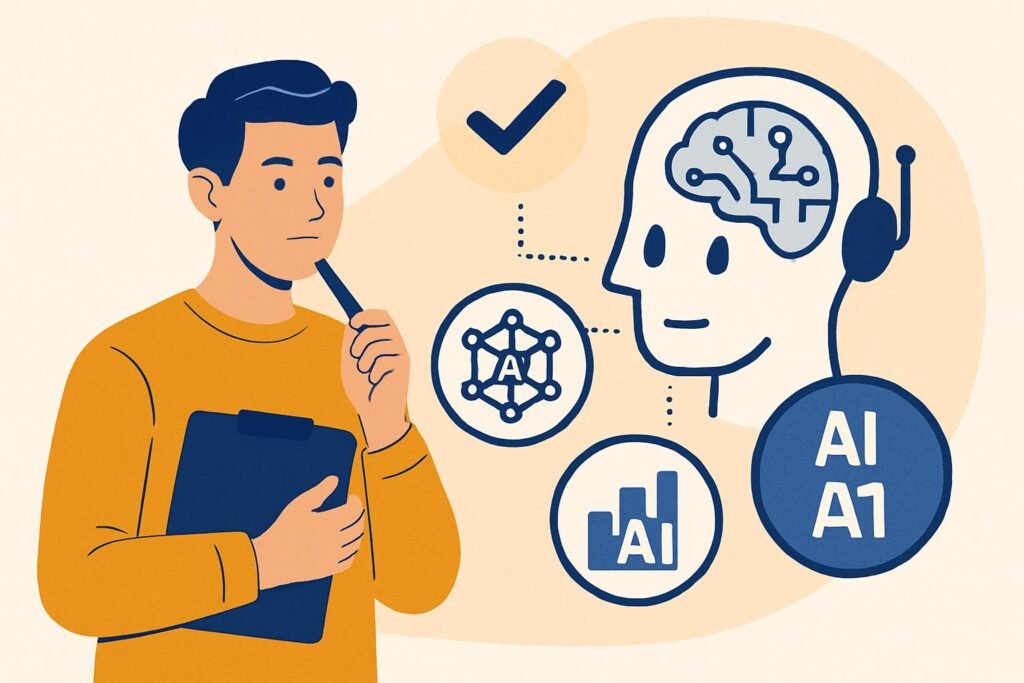
Choosing the Right AI Model Explained
Choosing the Right AI Model Explained breaks down the common challenge of selecting the most effective artificial intelligence model for your organization’s needs. With AI becoming increasingly important across industries, business leaders and technology teams often experience confusion about where to begin and which models to rely on. This guide simplifies AI model selection by combining expert insights, decision frameworks, and comparison visuals, helping you align choices with your real-world objectives. Whether you are developing in-house systems or integrating existing models, this resource offers practical guidance.
Key Takeaways
- Different AI model types such as generative, predictive, and NLP support various business functions and tasks.
- Clear definition of business goals, data availability, and technical capabilities is essential for effective AI model selection.
- Your decision to use a pre-trained or custom-built model will depend on cost, domain precision, scalability, and time-to-deployment.
- Visual comparisons, decision matrices, and use case examples simplify the evaluation process.
Understanding AI Model Types by Objective
The first step in choosing the right AI model is identifying your organization’s primary goal. Different types of AI models are designed to solve different classes of problems. Below is a breakdown of major model types and their typical applications.
1. Generative AI Models
Generative models create new content such as text, images, or code. These models are widely used in design, marketing, and software development. Examples include GPT-based language models and image generators like Stable Diffusion.
- Use Cases: Creative writing, automated image generation, code suggestions
- Examples: ChatGPT, Midjourney, Bard
- Pros: Easily accessible through pre-trained APIs, fast to implement, minimal integration effort
- Cons: May produce inaccurate content, lower precision in domain-specific tasks
2. Predictive Analytics Models
These models leverage historical data to forecast trends and outcomes. They include algorithms for regression, classification, and time series analysis. You can learn about one such foundational technique in this guide on how to use linear regression in machine learning.
- Use Cases: Sales forecasting, fraud prediction, churn analysis
- Examples: Logistic regression, Random Forest, XGBoost
- Pros: High accuracy with structured data, often provides interpretable results
- Cons: Requires well-organized datasets, less effective with images or text
3. Natural Language Processing (NLP) Models
NLP models interpret and manipulate human language. These are highly useful for customer support systems and automation of text-heavy workflows.
- Use Cases: Automated chat systems, voice transcription, document summarization
- Examples: BERT, RoBERTa, spaCy
- Pros: Performs well with language-based data, supports multiple languages
- Cons: Once trained, these models may be expensive to fine-tune, especially for niche domains
Decision-Making Framework to Choose the Best AI Model
Choosing the best-fit AI model involves evaluating your environment across factors such as objectives, data, technical capability, and budget. The table below offers a simple comparison between pre-trained and custom models.
| Criterion | Pre-Trained AI Models | Custom-Built AI Models |
|---|---|---|
| Speed to Deployment | High, ready for immediate use | Low, requires extended development |
| Cost | Lower upfront costs, pay-per-use models available | Higher costs due to engineering and infrastructure |
| Domain-Specific Accuracy | Moderate, works across general use cases | High, tailored for specific industries or use cases |
| Scalability | Best suited for small to medium-scale applications | Excellent for enterprise-level scale when architected properly |
This matrix helps determine whether you should start with accessible pre-trained options or invest in tailored models that fit your business environment more precisely.
AI Model Selection Guide by Industry
Each industry applies AI for specific goals and faces unique constraints. Here is how model preferences vary by field:
- Finance: Classification models are used for fraud detection and credit risk analysis.
- Healthcare: Mix of generative models for radiology training data and NLP for analyzing patient records.
- Retail: Recommendation systems and cluster analysis enhance personalization strategies.
- Manufacturing: Predictive maintenance depends on time series models and anomaly detection.
- Education: Personalized tutoring systems draw on generative and adaptive models.
Key Factors in AI Model Decision Making
Evaluate your internal and external constraints by focusing on four critical pillars.
1. Business Objective Fit
Specify whether you are solving for forecasting, automation, content generation, or recognition tasks. This will guide your selection among regression, generative, or NLP models. For those starting out, our guide on how to get started with machine learning helps outline early steps.
2. Data Volume and Type
Structured data such as numerical tables supports classic machine learning models. Text, audio, and visual inputs may call for specialized deep learning or NLP pipelines. For contrasting model types and their typical usage, review this explanation of machine learning algorithms.
3. Internal Capabilities
Assess what expertise you can leverage within your organization. If your team lacks AI skills, using cloud-based platforms like AWS JumpStart or Google Vertex AI helps reduce implementation risk.
4. Cost, Compliance, and Security
Sectors dealing with sensitive data must prioritize transparency and auditability. In such cases, consider models that can offer explainability to ensure trust and alignment with regulations.
Real-World Use Case Examples
- Retail Example: An online retailer starts with a pre-trained product recommendation API. As customer data grows, the company transitions to a custom collaborative filtering system, improving engagement and sales conversion.
- Insurance Example: An insurer processes thousands of claim documents using optical character recognition and NLP for summarization, significantly reducing manual labor.
- Fintech Example: A financial services startup trains a fraud detection classifier on proprietary transaction data. Off-the-shelf alternatives proved ineffective due to high false-positive rates.
Common Mistakes to Avoid
- Deploying complex models when simpler heuristics or rule-based systems would solve the problem
- Choosing a model without access to sufficient and relevant training data
- Overlooking latency requirements and runtime constraints in production systems
- Neglecting bias mitigation and explainability in regulated environments
Future-Proofing Your Model Choices
Prepare your AI infrastructure to adapt over time. Select models that support transfer learning, modular retraining, and version control. Integrate MLOps pipelines to automate monitoring, retraining, and performance optimization.
Final Thoughts
AI model selection is both a technical and strategic decision. A model that performs well in one setting may fail in another. Match your decision to your organization’s business objectives, data condition, execution timeline, and team capabilities.
References
Brynjolfsson, Erik, and Andrew McAfee. The Second Machine Age: Work, Progress, and Prosperity in a Time of Brilliant Technologies. W. W. Norton & Company, 2016.
Marcus, Gary, and Ernest Davis. Rebooting AI: Building Artificial Intelligence We Can Trust. Vintage, 2019.
Russell, Stuart. Human Compatible: Artificial Intelligence and the Problem of Control. Viking, 2019.
Webb, Amy. The Big Nine: How the Tech Titans and Their Thinking Machines Could Warp Humanity. PublicAffairs, 2019.
Crevier, Daniel. AI: The Tumultuous History of the Search for Artificial Intelligence. Basic Books, 1993.


